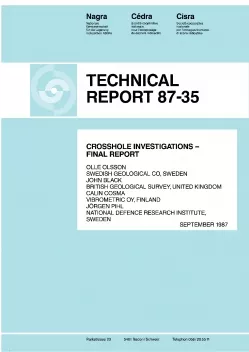
Technical Report NTB 87-35
Crosshole investigations –Final report
The Crosshole programme has comprised the development of borehole radar, borehole seismic, and hydraulic testing methods. These methods provide data on the electric, elastic, and hydraulic properties of the rock. For each of these methods new equipment has been developed, field tests have been performed, interpretation techniques developed and tested on the obtained data. Finally, a comparison of the results obtained with the different methods has been made.
During the course of the Crosshole project the radar and seismic methods have been taken from the prototype stage into being practical site characterization tools.
The analysis of the radar and seismic data has given a consistent description of the fracture zones at the Crosshole site in agreement with geological and other geophysical observations made in the boreholes. The geophysical methods have achieved a resolution of a few metres combined with probing ranges of a few hundred metres.
The hydraulic investigations within the Crosshole project have yielded substantial progress in assessing the hydrogeology of fractured granitic rocks. The crosshole hydraulic testing concentrated on measuring the distribution of hydraulic properties within the extensive fractured zones identified by geophysics. An approach was adopted based on a sinusoidally varying pressure and flow rate to minimize testing time and to allow the signal to be observed against a changing background.
A new analysis involving the "dimension" of the flow test has been developed to analyse the results of the crosshole sinusoidal testing. This is a versatile analysis well-suited to the sort of flow geometries likely to be found in crystalline rocks.
The combined analysis of the geophysical and the hydraulic data set has shown that groundwater flow is concentrated within a few major features which have been identified by the geophysical methods. The main features are considered to be broadly planar, containing patches of high and low hydraulic conductivity. The fracture zones are likely to be channelled, where the flow paths constitute a branching interconnecting network.
